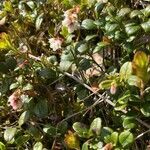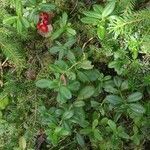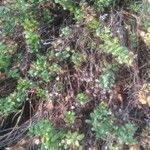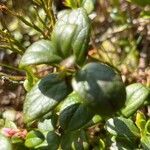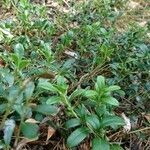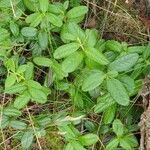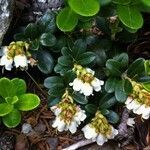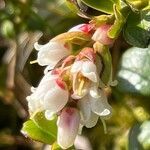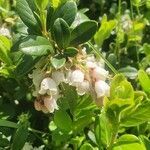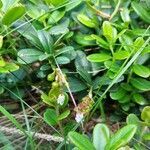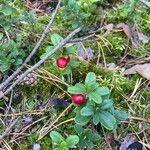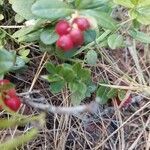Diffusely branched or prostrate shrub to 2 dm; lvs leathery, evergreen, subsessile, elliptic to obovate-oblong, 8–18 mm, rounded at both ends, sparsely dotted with erect black glands beneath; fls few in small terminal clusters, each on a short, glandular pedicel axillary to a bud-scale; sep glandular-ciliate; cor campanulate, 5–7 mm, 4-lobed nearly to the middle; stamens 8, included; fr red, edible, nearly 1 cm; 2n=24. In bogs and on rocks; boreal N. Amer. and Eurasia, s. to the higher mts. of N. Engl., the shore of Me., and to Minn. and B.C. (Vitis-idaea vitis-idaea; Vitis-idaea punctata)
A creeping low evergreen shrub. It forms mats. It grows 15 cm high and spreads 0.6-1.2 m wide. The leaves are small and oval. They are 5-20 mm long and 5 mm wide. They are deep green but have black spots underneath. The leaves turn bronze colour in autumn. The flowers are white or pink and bell shaped. They are in clusters. The fruit are bright red and juicy. They are 6-8 mm across. They are edible. There are several named cultivated varieties.
Plants densely colonial, frequently mat-forming; twigs of previous year green, terete, puberulent, not verrucose. Leaf blades pale and glandular abaxially, bright green adaxially, elliptic to obovate, 5-18 × 3-9 mm, glaucous-coriaceous, margins entire, slightly revolute. Pedicels 4-6 mm. Flowers: corolla pinkish white, 3-5 mm; filaments puberulent. Berries red, 8-10 mm diam. 2n = 24.
